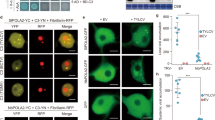Abstract.
Geminiviruses are DNA viruses which infect plants. They have a small genome and encode only a few proteins. Therefore, their DNA replication cycle relies largely on the use of cellular DNA replication proteins. The strategy used by geminiviruses to replicate their single-stranded DNA (ssDNA) genome consists of a first stage of conversion of ssDNA into double-stranded DNA (dsDNA) intermediates and, then, the use of dsDNA as a template to amplify viral dsDNA and to produce mature ssDNA genomes by a rolling-circle replication mechanism. In addition, the accumulating evidence indicates that viral DNA replication is somehow coupled to the cell cycle regulatory network of the infected cell. For these reasons, geminiviruses are excellent model systems to understand the regulation of DNA replication and cell cycle in plant cells. Recent years have witnessed significant progress in the identification of cis-acting signals and their interaction with trans-acting factors that contribute to geminivirus origin function. These and other aspects of the geminivirus DNA replication cycle will be reviewed.
Similar content being viewed by others
Author information
Authors and Affiliations
Additional information
Received 15 February 1999; received after revision 12 May 1999; accepted 12 May 1999
Rights and permissions
About this article
Cite this article
Gutierrez, C. Geminivirus DNA replication. CMLS, Cell. Mol. Life Sci. 56, 313–329 (1999). https://doi.org/10.1007/s000180050433
Issue Date:
DOI: https://doi.org/10.1007/s000180050433




